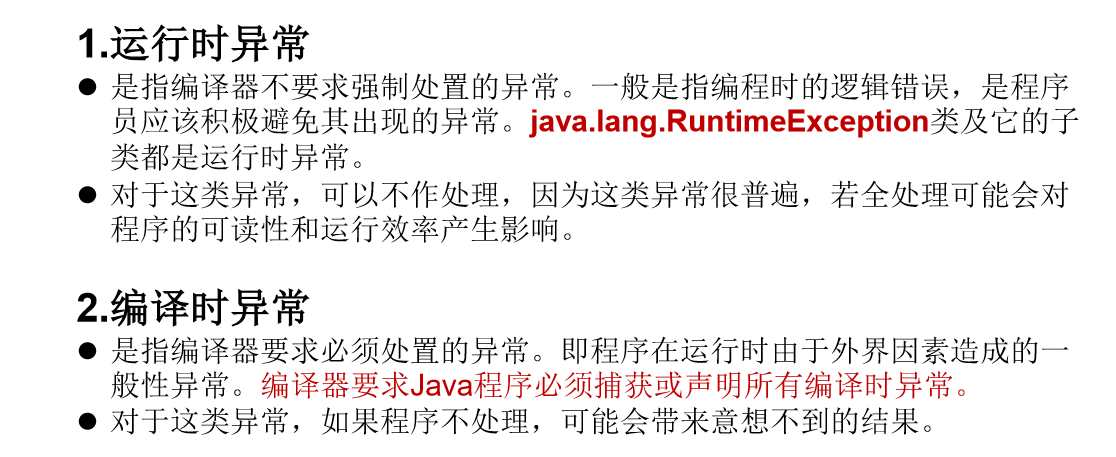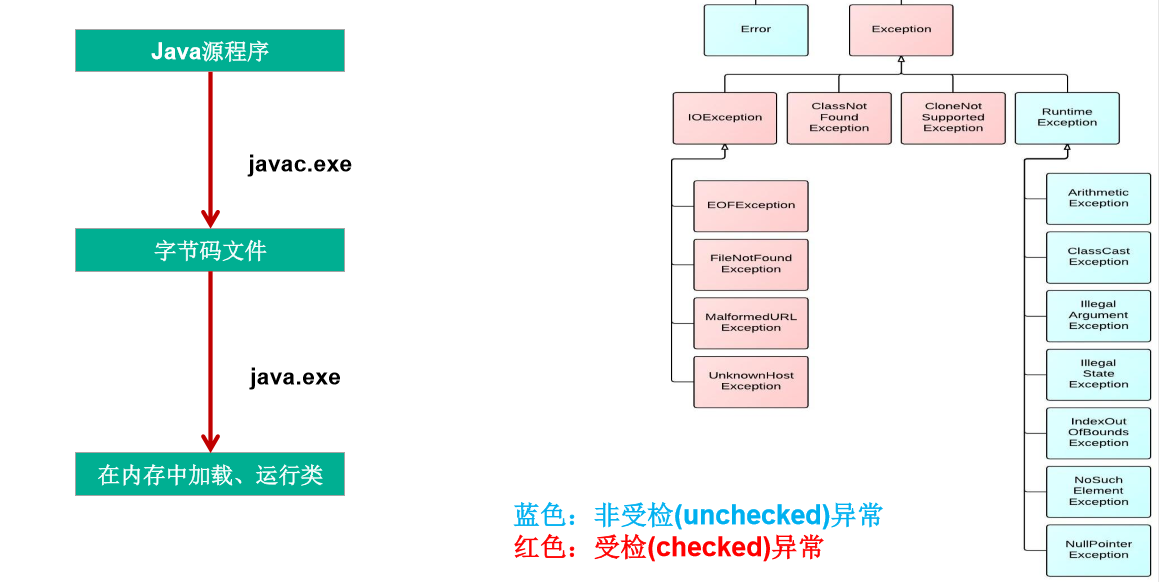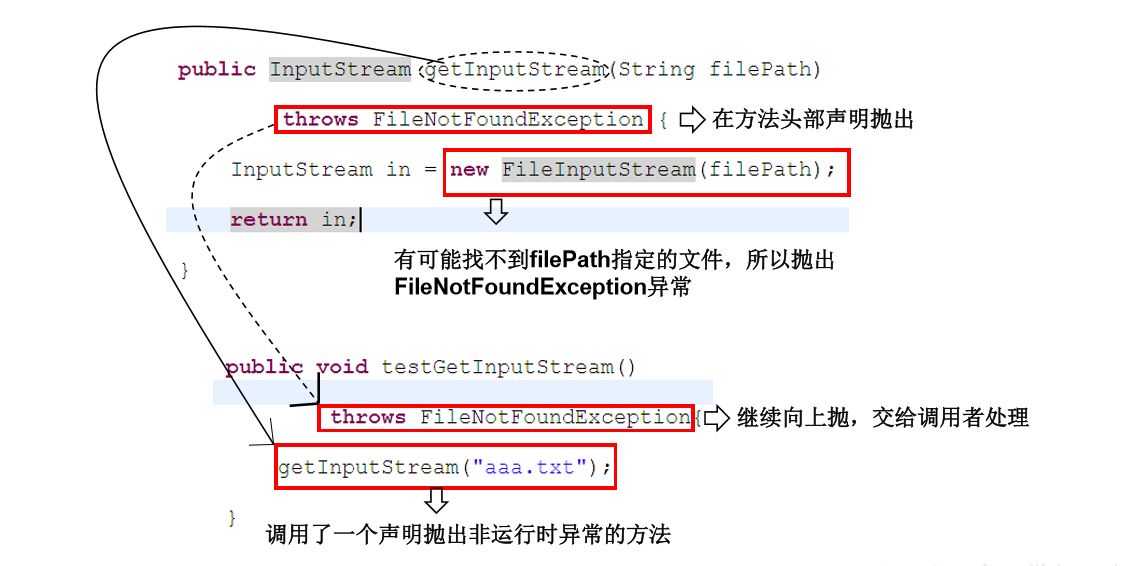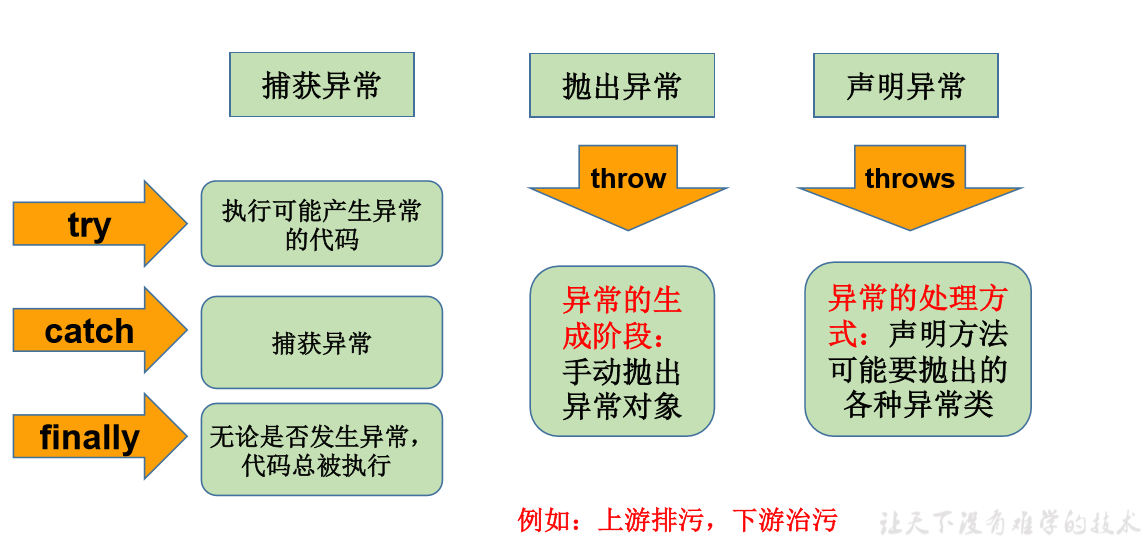Java异常处理
1 - 引子
/*
在使用计算机语言进行项目开发的过程中,即使程序员把代码写得尽善尽美,在系统的运行过程中仍然会遇到一些问题,因为很多问题不是靠代码能够避免的,比如:客户输入数据的格式,读取文件是否存在,网络是否始终保持通畅等等
*/
2 - 什么是异常?
/*
1. 异常:在Java语言中,将程序执行中发生的不正常情况称为“异常”。 (开发过程中的语法错误和逻辑错误不是异常)
2. Java程序在执行过程中所发生的异常事件可分为两类:
Error:Java虚拟机无法解决的严重问题。如:JVM系统内部错误、资源 耗尽等严重情况。比如:StackOverflowError和OOM。一般不编写针对性 的代码进行处理。
Exception: 其它因编程错误或偶然的外在因素导致的一般性问题,可以使 用针对性的代码进行处理,例如:
1空指针访问
2试图读取不存在的文件
3网络连接中断
4数组角标越界
3. 对于这些错误,一般有两种解决方法:一是遇到错误就终止程序 的运行。另一种方法是由程序员在编写程序时,就考虑到错误的 检测、错误消息的提示,以及错误的处理
4. 捕获错误最理想的是在编译期间,但有的错误只有在运行时才会发生。 比如:除数为0,数组下标越界等
分类:编译时异常和运行时异常
*/

package com.lzh.error; /* * Error:Java虚拟机无法解决的严重问题。如:JVM系统内部错误、资源 耗尽等严重情况。比如:StackOverflowError和OOM。一般不编写针对性 的代码进行处理 */ public class ErrorTest { public static void main(String[] args) { // 1.java.lang.StackOverflowError 栈溢出 // main(args); // 2.java.lang.OutOfMemoryError 堆溢出 Integer[] array = new Integer[1024*1024*1024]; } }
编译时异常和运行时异常

3 - 异常体系结构
/*
异常体系结构
java.lang.Throwable
①java.lang.Error:一般不编写针对性的代码进行处理
②java.lang.Exception:可以进行异常的处理
1.编译时异常(checked)
IOException FileNotFoundException ClassNotFoundException
2.运行时异常(unchecked)
NullPointerException
ArrayIndexOutOfBoundsException
ClassCastException
NumberFormatException
InputMismatchException
*/

package com.lzh.error; import java.util.Date; import java.util.Scanner; import org.junit.jupiter.api.Test; public class ExceptionTest { // NullPointerException 空指针异常 @Test public void test1() { Integer[] array = null; // 空指针举例 System.out.println(array[0]); } // ArrayIndexOutOfBoundsException 角标越界 @Test public void test2(){ int[] array = new int[2]; // 数组角标越界举例 System.out.println(array[2]); } // ClassCastException 类型转换异常 @Test public void test3() { Object obj = new Date(); String str = (String)obj; System.out.println(str); } // NumberFormatException 数字转换异常 @Test public void test4() { String num = "123a"; int number = Integer.parseInt(num); System.out.println(number); } // InputMismatchException 输入不匹配 @Test public void test5() { Scanner scanner = new Scanner(System.in); int score = scanner.nextInt(); // 键盘输入abc System.out.println(score); } }
异常体系结构图解

4 - 异常处理机制1 try-catch-finally
/*
异常处理:抓抛模型
过程1:"抛" -> 程序在正常执行的过程中,一旦出现异常,就会在异常代码处生成一个对应异常类的对象,并将此对象抛出,一旦抛出对象以后,其后的代码不在执行。
过程2:"抓" -> ① try-catch-finally ② throws
try-catch-finally的使用
try{
// 可能出现异常的代码
}catch(异常类型1 变量1){
// 处理异常的方式1
}catch(异常类型2 变量2){
// 处理异常的方式2
}
...
finally{
// 一定会执行的代码
}
说明:
1 - finally是可选的,且可以相互嵌套
2 - 使用try将可能出现异常代码包装起来,在执行过程中,一旦出现异常,就会生成一个对应异常类的对象,根据此对象的类型,去catch中进行匹配。
3 - 一旦try中的异常对象匹配到某个catch时,就进入catch中进行异常的处理。一旦处理完成,就跳出当前的try-catch结构(没有finally的情况),继续执行其后的代码。
4 - catch中的异常类型如果没有子父类关系,则谁声明在上,谁声明在下无所谓。catch中的异常类型如果满足子父类关系,则要求子类一定声明在父类上面。否则报错
5 - 常用的异常对象处理方式:①String getMessage() ②printStackTrace()
6 - try结构中声明的变量,出了结构就不能再被调用
*/

public class ExceptionTest1 { // try-catch-finally的使用 @Test public void test1() { String str = "123a"; try { int number = Integer.parseInt(str); System.out.println("hello"); }catch(NumberFormatException e) { // System.out.println(e.getMessage()); // System.out.println("数值转换异常"); e.printStackTrace(); }catch(NullPointerException e) { System.out.println(e); System.out.println("空指针异常"); }catch(Exception e) { } System.out.println("321"); } }
5 - try-catch-finally中finally的使用
/*
try-catch-finally中finally的使用:
1.finally是可选的
2.finally中声明的是一定会被执行的代码。即使catch中又出现了异常,try中又return语句,catch中有return语句等情况。
3.像数据库连接、输入输出流、网络编程Socket等资源。jvm是不能自动回收的,就需要我们手动的进行资源的释放。此时的资源释放,就需要声明在finally中。
体会1:使用try-catch-finally处理编译时异常,使得程序在编译时就不报错,但是运行时仍可能报错,相当于我们使用try-catch-finally将一个编译时可能出现的异常,延迟到运行时出现
体会2:开发中,由于运行时异常比较常见,所以我们通常就不针对运行时异常编写try-catch-finally了。正对于编译时异常,我们说一定要考虑异常的处理。
*/

package com.lzh.error; import java.util.Scanner; import org.junit.Test; public class FinallyTest { @Test public void test2() { Scanner scanner = new Scanner(System.in); int score = 0; try { System.out.print("请输入成绩:"); score = scanner.nextInt(); }catch(Exception e) { System.out.println(e); }finally { scanner.close(); // 回收资源 System.out.println("成绩是"+score); } } @Test public void test1() { try { int a = 0; int b = 1; System.out.println(b/a); }catch(Exception e) { System.out.println(e); int[] array = new int[2]; System.out.println(array[2]); }finally{ System.out.println("一定会执行这里"); } } }
6 - 异常处理机制2 throws
/*
声明抛出异常是Java中处理异常的第二种方式
1 - 如果一个方法(中的语句执行时)可能生成某种异常,但是并不能确定如何处理这 种异常,则此方法应显示地声明抛出异常,表明该方法将不对这些异常进行处理, 而由该方法的调用者负责处理
2 - 在方法声明中用throws语句可以声明抛出异常的列表,throws后面的异常类型可 以是方法中产生的异常类型,也可以是它的父类
3 - 声明抛出异常:throw + 异常类型
"throw + 异常类型"写在方法的声明处。指明此方法执行时,可能会抛出的异常类型。一旦当方法体执行时,出现异常,仍会在异常代码处生成一个异常类的对象。此对象满足throw后异常类型时,就会被抛出,异常代码后续的代码,就不再执行
4 - 体会:try-catch-finally -> 真正的将异常给处理掉。而throws的方式只是将异常抛给了方法的调用这。并没有真正处理掉异常
5 - 开发中如何选择使用try-catch-finally 还是使用throws?
①如果父类中被重写的方法没有throws方式处理异常,则子类重写的方法也不能使用throw是,意味着如果子类重写的方法中有异常,必须使用try-catch-finally方法处理
②执行的方法a中,先后又调用了另外的几个方法,这几个方法是递进关系执行的。我们建议这几个方法使用throws的方式进行处理,而执行的方法a可以考虑使用try-catch-finally方式进行处理。
*/

import java.io.File; import java.io.FileInputStream; import java.io.FileNotFoundException; import java.io.IOException; public class ThrowTest { public static void main(String[] args) { try { method2(); }catch(IOException e) { e.printStackTrace(); } } public static void method2() throws IOException{ method1(); } public static void method1() throws FileNotFoundException,IOException{ File file = new File("hello.txt"); FileInputStream fis = new FileInputStream(file); int data = fis.read(); while(data != -1) { System.out.println((char)data); data = fis.read(); } fis.close(); } }
图解

7 - 重写方法声明抛出异常的原则

8 - 手动抛出异常 throw
/*
关于异常对象的产生:
①系统自动生成的异常对象
②手动的生成一个异常对象,并抛出(throw)
throw 的使用,见代码
*/

package com.lzh.error; /* * 关于异常对象的产生: * ①系统自动生成的异常对象 * ②手动的生成一个异常对象,并抛出(throw) */ public class StudentTest { public static void main(String[] args) { try { Student s = new Student(); s.regist(-1001); System.out.println(s); } catch (Exception e) { // e.printStackTrace(); System.out.println(e.getMessage()); } } } class Student{ int id; public void regist(int id) throws Exception{ if(id > 0) { this.id = id; }else { // System.out.println("输入格式错误!"); // 手动抛出异常对象 // throw new RuntimeException("您输入的数据非法!"); throw new Exception("您输入的数据非法!"); } } }
9 - 开发者自定义异常类
/*
1 一般地,用户自定义异常类都是RuntimeException的子类。
2 自定义异常类通常需要编写几个重载的构造器。
3 自定义异常需要提供serialVersionUID
4 自定义的异常通过throw抛出。
5 自定义异常最重要的是异常类的名字,当异常出现时,可以根据名字判断异常类
*/

package com.lzh.error; /* * 如何自定义异常类 * 1.继承现有的异常结构:RuntimeException Exception * 2.提供全局常量:serialVersionUID * 3.提供构造器 */ // 自定义异常类 public class MyException extends RuntimeException{ static final long serialVersionUID = -3387516993124229948L; public MyException() { } public MyException(String message) { super(message); } // 测是自定义类 public static void main(String[] args) { Students s1 = new Students(); s1.register(1001); System.out.println(s1.id); try { Students s2 = new Students(); s2.register(-1002); } catch (Exception e) { System.out.println(e.getMessage()); } } } class Students{ int id; public Students() { } public void register(int id) { if(id > 0) { this.id = id; }else { throw new MyException("不能输入负数!"); // 错误示例:只有异常类才可以throw // throw new String("1111"); } } }
10 - 异常处理练习

package com.lzh.exception_exer; /* 编写应用程序EcmDef.java,接收命令行的两个参数,要求不能输入负数,计算 两数相除。 对 数 据 类 型 不 一 致 (NumberFormatException) 、 缺 少 命 令 行 参 数 (ArrayIndexOutOfBoundsException、 除0(ArithmeticException)及输入负数(EcDef 自定义的异常)进行异常处理。 提示: (1)在主类(EcmDef)中定义异常方法(ecm)完成两数相除功能。 (2)在main()方法中使用异常处理语句进行异常处理。 (3)在程序中,自定义对应输入负数的异常类(EcDef)。 (4)运行时接受参数 java EcmDef 20 10 //args[0]=“20” args[1]=“10” (5)Interger类的static方法parseInt(String s)将s转换成对应的int值。 如:int a=Interger.parseInt(“314”); //a=314; */ public class EcmDef { public static void main(String[] args) { try { int i = Integer.parseInt(args[0]); int j = Integer.parseInt(args[1]); int result = ecm(i, j); System.out.println(result); }catch(NumberFormatException e){ System.out.println("数据类型不一致"); }catch(ArrayIndexOutOfBoundsException e){ System.out.println("缺少命令行参数"); }catch(ArithmeticException e){ System.out.println("0不能做除数"); }catch(MyException e){ System.out.println(e.getMessage()); } } public static int ecm(int i,int j) throws MyException { if(i < 0 || j < 0){ throw new MyException("不能输入负数哦!"); } return i / j; } }

package com.lzh.exception_exer; // 自定义的异常类 public class MyException extends Exception{ static final long serialVersionUID = -338751699324229948L; public MyException(){ } public MyException(String message){ super(message); } }
11 - 异常处理五个关键字总结
/*
throw 和 throws 的区别?
throw 表示抛出一个异常类的对象,生成异常对象的过程,声明在方法体内。
throws 属于异常处理的一种机制,声明在方法声明处。
*/



